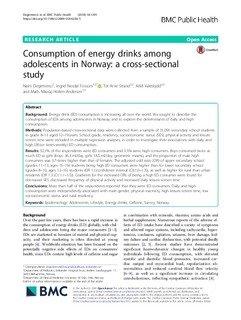Consumption of energy drinks among adolescents in Norway: a cross-sectional study
Degirmenci, Naim; Fossum, Ingrid Nesdal; Strand, Tor A; Vaktskjold, Arild; Holten-Andersen, Mads Nikolaj
Peer reviewed, Journal article
Published version
Permanent lenke
http://hdl.handle.net/11250/2589097Utgivelsesdato
2018Metadata
Vis full innførselSamlinger
Sammendrag
Background Energy drink (ED) consumption is increasing all over the world. We sought to describe the consumption of EDs among adolescents in Norway, and to explore the determinants of daily and high consumption. Methods Population-based cross-sectional data were collected from a sample of 31,091 secondary school students in grade 8–13 aged 12–19 years. School grade, residency, socioeconomic status (SES), physical activity and leisure screen time were included in multiple regression analyses, in order to investigate their associations with daily and high (≥four times weekly) ED consumption. Results 52.3% of the respondents were ED consumers and 3.5% were high consumers. Boys consumed twice as much ED as girls (boys: 36.3 ml/day, girls: 18.5 ml/day, geometric means), and the proportion of male high consumers was 3.7-times higher than that of females. The adjusted odd ratio (OR) of upper secondary school (grades 11–13, ages 15–19) students being high ED consumers were higher than for lower secondary school (grades 8–10, ages 12–15) students (OR 1.1(confidence interval (CI):1.0–1.3)), as well as higher for rural than urban residents (OR 1.3 (CI: 1.1–1.5)). Gradients for the increased ORs of being a high ED consumer were found for decreased SES, decreased frequency of physical activity and increased daily leisure screen time. Conclusions More than half of the respondents reported that they were ED consumers. Daily and high consumption were independently associated with male gender, physical inactivity, high leisure screen time, low socioeconomic status and rural residency. Consumption of energy drinks among adolescents in Norway: a cross-sectional study
